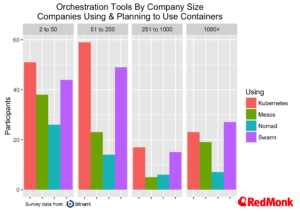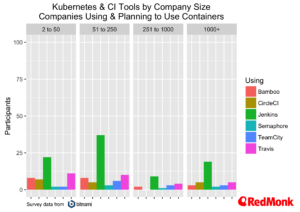Over the last week we have had the opportunity to work with a large set of data collected by Bitnami (full disclosure: Bitnami is a RedMonk client). Bitnami collected this data by means of a user survey across their entire user base, and the survey garnered over 5,000 responses from a request sent to Bitnami’s e-mail distribution list of over 850K. With any data set of this nature, it is important to state that survey results strictly reflect the members of the Bitnami e-mail distribution list.
The data set covered areas including container usage and plans, orchestration tools where containers were being used, CI tools and database choices. For this post we will be focusing on the data around containers and CI.
What makes this data very interesting is the number of companies who are actively using and evaluating containers versus those that are not. One of the issues with many surveys of container users is the automatic bias inherent in the selection criteria. While this data does not eliminate this bias, it does provide some interesting counter balances.
The Population
The overall population breaks out with just over 30% individual developers and the remainder as employees in companies of varying sizes. For the purposes of this analysis we will ignore individual participants, and focus on four sets of users, looking first at those using or planning to use containers.
- Companies between 2 and 50 employees
- Companies between 50 and 250 employees
- Companies between 250 and 1000 employees
- Companies with over 1000 employees
Container Usage and Plans?

The first interesting stat that jumped out is the number of participants who stated they are using containers currently, and those that are planning to use containers in the future, and are currently evaluating and developing a container strategy.
We next looked at a breakdown of container usage plans by company size
CI Usage Across All Participants
We also looked at the level of CI Usage across all participants
What sticks out here is how many participants are either on manual build processes or have no CI process at all in place. We have commented previously as to just how important CI is as part of the cloud native journey, and for most people looking to use containers at scale CI is where they will need to start.
For those that are using CI, Jenkins, unsurprisingly, comes out with a strong lead.
Deep Dive – Orchestration Tools
Among those using or planning to use containers we next looked at the types of deployments they currently have.
As one would expect at this stage of the adoption cycle test/dev far outweighs everything else, with the those running orchestration for less than 50 nodes coming next.
Diving deeper into the orchestration tools, we looked at the orchestration tools organisations of different sizes were looking at.
Kubernetes was the overall leader here, but a large number of participants are using Docker Swarm. Mesos continues to have a strong foothold as well.
We next looked at the breakdown of how each orchestration tool was being used across each size of enterprise.
Docker Swarm
Kubernetes
Mesos
Nomad
Reflecting our earlier findings, test/dev is the predominant workload across all company sizes.
CI Approaches of Container Users
Once again the level of manual deployment, be it either with a CI system or as a completely manual approach was very surprising, looking further into this data, we did a breakdown across the main orchestration tools, and looked at which CI tools participants are using in conjunction with the various orchestration tools.
Docker Swarm
Kubernetes
Mesos
Nomad
Conclusions
A number of trends come through very clearly in the data from the Bitnami survey. Firstly companies still have a journey to go on using CI and CD. In our opinion this is absolutely critical for cloud native applications.
Secondly Docker Swarm has a much stronger presence in the orchestration tools space within this survey population than many commentators believed. Given that this was in advance of yesterdays announcements around Docker 1.12 and Swarm we would expect to see significantly more competition in this space.
Finally the scale of deployments from the respondents to this survey is still relatively low, with very few companies having over 200 nodes in production. We do expect to see this change over the coming year.
Disclaimers: Bitnami, Docker, Atlassian (makers of Bamboo) are current RedMonk clients.














KubeWeekly #42 – KubeWeekly says:
June 27, 2016 at 5:05 pm
[…] Container Trends: Plans, Orchestration and CI – A Dataset from Bitnami […]
KubeWeekly #43 – KubeWeekly says:
July 5, 2016 at 4:09 pm
[…] Container Trends: Plans, Orchestration and CI – A Dataset from Bitnami […]
Links 8/7/2016: Kubernetes 1.3, New Linux Foundation Events | Techrights says:
July 8, 2016 at 9:39 am
[…] Container Trends: Plans, Orchestration and CI – A Dataset from Bitnami […]
KubeWeekly #44 – KubeWeekly says:
July 11, 2016 at 4:28 pm
[…] Container Trends: Plans, Orchestration and CI – A Dataset from Bitnami […]
KubeWeekly #45 – KubeWeekly says:
July 18, 2016 at 5:08 pm
[…] Container Trends: Plans, Orchestration and CI – A Dataset from Bitnami […]